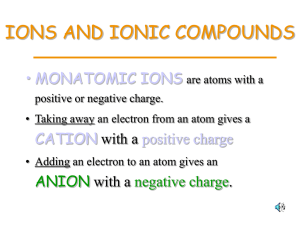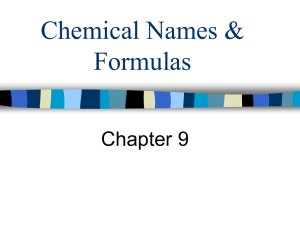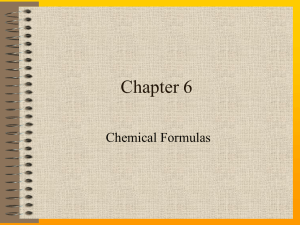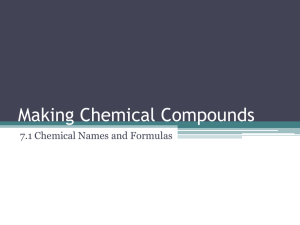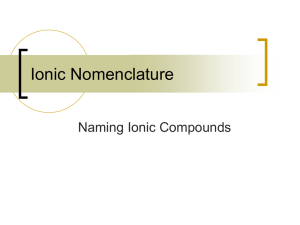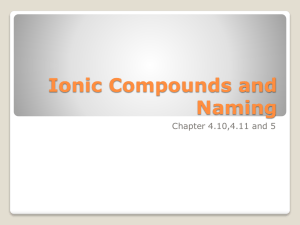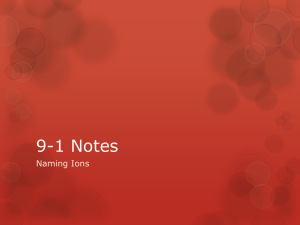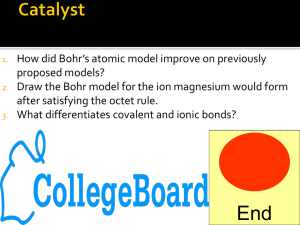binary ionic compounds
advertisement
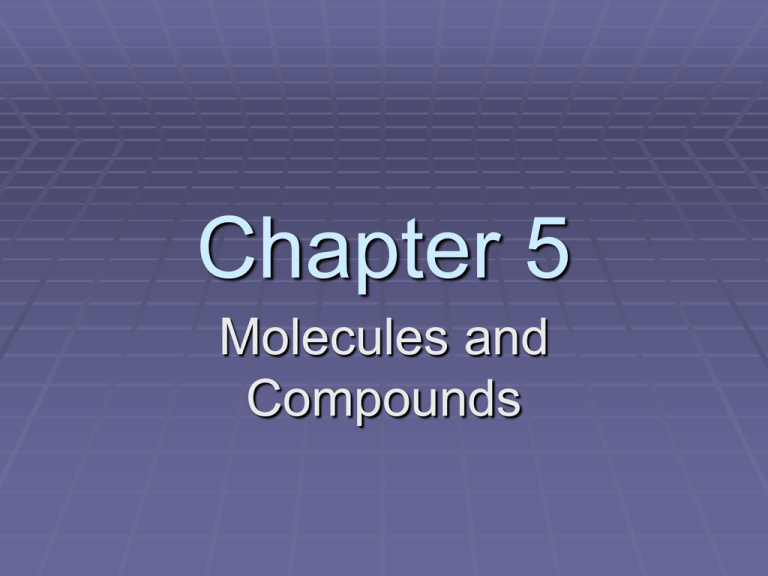
Chapter 5 Molecules and Compounds Homework Assigned Problems (odd numbers only) Required “Problems” 23-79 (odd) “Cumulative Problems” 81-97 (odd) Highlight Problems “Highlight Problems” 99, 101 (odd) Compounds Display Constant Composition Compounds are pure substances consisting of two or more elements held together by a chemical bond A compound can be broken into its elements by a chemical process The percentage of each element in a specific compound does not vary The Law of Definite Proportions (Constant Composition): In a pure compound, the elements are always present in the same definite proportions by mass Compounds Display Constant Composition Example: Two samples of ammonia gas with different sample masses Upon decomposition, the mass ratios of nitrogen to hydrogen are the same Sample 1: 1.513 g 4.63 0.327 g Sample 2: 1.644 g 4.62 0.356 g Chemical Formulas: How to Represent Compounds Chemical formulas are a concise way of stating a specific chemical compound’s composition The notation contains the symbols of the elements present and the subscripts to indicate the number of atoms per element in a structural unit of the compound Aspirin’s chemical formula is C9H8O4 Element symbols 21 atoms are present: 9 carbon atoms, 8 hydrogen atoms, and 4 oxygen atoms Ratio of C to H to O is 9:8:4 subscripts Chemical Formulas: How to Represent Compounds All pure samples of a compound have the same composition If only one atom is present in a molecule, the subscript “1” is omitted Follow the capitalization rules for elemental symbols Co is the symbol for cobalt CO is the formula for carbon monoxide When writing formulas, list the metal or most metallic element first sodium chloride NaCl carbon dioxide CO2 not not ClNa O 2C Chemical Formulas: How to Represent Compounds If a chemical formula contains groups of atoms in parentheses, the subscript following the parentheses indicates the number polyatomic units in the formula Number of atoms is determined by multiplying the subscript outside the parenthesis by the subscript for every atom inside the parenthesis Composition is 1 Mg atom, 2 N atoms, 6 O atoms Polyatomic ion A Molecular View of Elements and Compounds Pure substances Elements Atomic Molecular Compounds Ionic Molecular Elements and Compounds Elements are substances that cannot be decomposed into simpler substances Each element is composed of only one type of atom Most elements are atomic elements and exist as single atoms (monatomic) Molecular elements are found naturally as two or more of the same type of atom bound together (diatomic) Elements and Compounds A compound can be decomposed into two or more simpler substances The ultimate breakdown products are elements Two types of compounds Molecular Ionic Molecular Compounds A molecule is a group of two or more atoms bound together as a unit A molecular compound involves a bond between two or more nonmetals Bonds occur between different or identical atoms The individual molecule is the smallest particle that can exist as a stable, independent unit of the compound Molecular (Covalent) Compounds Molecular compounds are compounds composed of molecules that exist as the individual structural unit The simplest molecule contains two atoms (diatomic). They can be the same or different atoms Next in complexity are triatomic and tetraatomic O2 O3 oxygen ozone A diatomic molecule A triatomic molecule CO H 2O carbon monooxide water A diatomic molecule A triatomic molecule Ionic Compounds Ionic compounds are compounds which are held together by the attraction of positive and negative ions Solid crystals formed by a very ordered packing of oppositely charged ions Most ionic compounds are composed of a metal and a nonmetal High melting temperatures Ionic Compounds Solids They do not exist as single molecules The chemical formula represents the simplest ratio that these atoms combine together Held strongly together, these ions are packed together into a “lattice” Each Na+ ion is surrounded on each side by Cl- ions Each Cl- ion is surrounded on each side by Na+ ions Cl– Na + Cl– Cl– Na + Cl– Na + Cl– Na + Cl– Na + Na + Fig4_21a Formula unit = NaCl Ionic Compounds vs. Molecular Compounds For molecular compounds, the chemical formulas give the composition of the molecules For ionic compounds, the chemical formulas give the ion ratio within the compound Writing Formulas for Ionic Compounds (Charge Balance in Ionic Compounds) Binary ionic compounds are composed of only two elements (metal and nonmetal) The symbol of the cation always precedes the symbol of the anion The sum of the positive charges (cation) must equal the sum of the negative charges (anion) Net charge is zero (charge-neutral) Subscripts written as whole numbers indicate the number of each ion in the formula unit Writing Formulas for Ionic Compounds Subscripts in Formulas Sodium Chloride Formed from sodium and chlorine atoms An ionic bond forms consisting of a sodium ion (+ charge) and a chloride ion (- charge) Each sodium loses one electron to achieve an octet Each chlorine atom gains one electron to achieve an octet Formula is NaCl Writing Formulas for Ionic Compounds Subscripts in Formulas Magnesium Chloride Formed from magnesium and two chlorines An ionic bond forms consisting of a magnesium ion (2+ charge) and two chloride ions (- charge each) Each magnesium loses two electrons to achieve an octet Each chlorine atom gains one electron to achieve an octet Formula is MgCl2 Writing Ionic Formulas for Ionic Charges Subscripts in a formula represent the number of positive and negative ions Write the formula for the ionic compound containing Na+ and N3- Na+ N •• • • 3- N •• •• •• • Na• •• •• Na+ •• Na• •• • Na• Gains Each loses 1e- 3e- • • • Na+ Net charge: 3(1+) + 1(3-)=0 Formula: Na3N Naming Ionic Compounds For ionic compounds containing two elements: Compounds containing a metal and a nonmetal are called binary ionic compounds Two types of metals: Single Cation Metals: Form one positive ion Multiple Cation Metals: Form more than one positive ion The systematic naming uses the name of the cation first, followed by the name of the anion Subscripts in the formula are not included in the name Types of Metal Ions Single Cation Metals (Type I) Form only one type of ion (one possible charge) Main group metals in groups IA, IIA, and some IIIA e.g. Sodium only forms one ion (Na+) in chemical reactions Determine charge by position on the periodic table (also see table 5.3 on page 136) Types of Metal Ions Single Cation Metals (Type I) Form only one type of ion (one possible charge) Main group metals in groups IA, IIA, and some IIIA e.g. Sodium only forms one ion (Na+) in chemical reactions Determine charge by position on the periodic table (also see table 5.3 on page 136) Types of Metal Ions Multiple Cation Metals (Type II) Form two or more types of ions (variable possible charge) Transition metals in groups 3B to 12B, and some 4A and 5A For example, iron forms two ions (Fe2+ and Fe3+) in chemical reactions Determine charge by the “stock system” for naming ions The metal name followed by a Roman numeral in parentheses to indicate its charge (see table 5.4 on page 136) Types of Metal Ions Multiple Cation Metals (Type II) Form two or more types of ions (variable possible charge) Transition metals in groups 3B to 12B, and some 4A and 5A For example, iron forms two ions (Fe2+ and Fe3+) in chemical reactions Determine charge by the “stock system” for naming ions The metal name followed by a Roman numeral in parentheses to indicate its charge (see table 5.4 on page 136) Naming Type I Binary Ionic Compounds Compounds which contain a positively charged metallic ion and a negatively charged nonmetallic ion Name metal cation first, name nonmetal anion second Single metal cation name is the metal name only, drop the word “ion” Nonmetal anion named by changing the ending on the nonmetal name to -ide Name of metal__base name of nonmetal + -ide Naming Type I Ionic Compounds NaI KCl Potassium Chloride Sodium Iodide Na3P CaF2 Calcium Fluoride Sodium Phosphide Rb2S Li2O Rubidium Sulfide Lithium Oxide Mg3N2 AgCl Magnesium Nitride Silver Chloride Naming Type II Binary Ionic Compounds Multiple Cation Metal Compounds Metal listed first in formula & name (same order as for Type I compounds) Determine metal cation charge from the anion charge Common multiple cations in Table 5.4, page 136 Naming Type II Binary Ionic Compounds Multiple Cation Metal Compounds Use the metal name (cation) first, followed by a Roman numeral in parentheses to indicate its charge Nonmetal anion named by changing the ending on the nonmetal name to -ide cation anion Name of metal (charge of metal)______base name of nonmetal + -ide Naming Type II Binary Ionic Compounds FeI3 1(?)+3(-1)=0 Iron (III) Iodide Cu2O 2(?)+1(-2)=0 Copper (I) Oxide SnBr2 1(?)+2(-1)=0 Tin (II) Bromide Naming Type II Binary Ionic Compounds Determining the Charge of the Cation from the Anion Determine the charge of Cu in Cu2O Write the name of the compound 1)Determine the charge of the cation from the anion Cu2O - the nonmetal anion is O, since it is in Group 6A, its charge is 2 Since there are 2 Cu ions in the formula and the total positive charge is 2+, divide by the number of cations so each Cu has a 1+ charge Naming Type II Binary Ionic Compounds Determining the Charge of the Cation from the Anion 2) Name the cation by its element name and use a Roman numeral in parenthesis to indicate its charge Copper (I) 3) Name the anion by changing the last part of its element name to –ide Oxygen oxide 4) Write the name of the cation first and the name of the anion second copper (I) oxide Naming Type II Binary Ionic Compounds Determining the Charge of the Cation from the Anion • SnI4 • 1(?)+4(-1)=0 • Tin (IV) iodide • HgO • 1(?)+1(-2)=0 • Mercury (II) Oxide • MnCl2 • 1(?)+2(-1)=0 • Manganese (II) Chloride Writing Formulas from the Name of an Ionic Compound Usually involves a metal and a nonmetal 1) Identify the cation and the anion 2) Balance the charges to write the formula If it is a multiple cation metal, the Roman numeral determines the charge of the cation 3) When writing the formula, take the name of the cation first, followed by the name of the anion Writing Formulas from the Name of an Ionic Compound Compound name is lithium chloride Li+ and Cl- are the ions Balance the charges Li Cl 1(1) 1 (1) 0 Write the formula LiCl is the formula using the subscripts from the charge balance Writing Formulas from the Name of an Ionic Compound Compound name is iron (III) oxide Fe3+ and O2- are the ions Balance the charges Fe 3 O2 2 (3) 3 (2) 0 Write the formula Fe2O3 is the formula using the subscripts from the charge balance Polyatomic Ions Polyatomic ions are a group of atoms covalently bonded together into a single unit The unit obtains a charge Most PA ions are negatively charged Oxyanions (anions): P, S, C, or N covalently bound to one or more oxygens Never occur independently, always associated with ions of opposite charge Only one PA is positively charged ammonium ion Naming Ionic Compounds Containing a Polyatomic Ion Must memorize name, formula and charge (Table 5.6 on page 138). Look for relationships between ions Most PA ions are oxyanions: The number of oxygen atoms bonded to the same element (e.g. P, S, or N) will determine the name (suffix) of the ion ~ate is most common ~ite has one less oxygen bonded Naming Ionic Compounds Containing a Polyatomic Ion ~ate, ~ite pairs of ions The ion in the pair with the most oxygens is always the ~ate ion The ion in the pair with one less oxygen is always the ~ite ion Ion pair with a 3- charge phosphate (PO43-), phosphite (PO33-) Ion pair with a 2- charge sulfate (SO42-), sulfite (SO32-) Ion pair with a 1- charge nitrate (NO3-), nitrite (NO2-) Naming Ionic Compounds Containing a Polyatomic Ion Group 7A elements can form more than two types of polyatomic ions (oxyanions) Additional prefixes are used to differentiate the ions See page 138-9 (class text) and page 330 (lab text) The number of oxygens attached to the central atom has an effect on the name of the ion e.g. Polyatomic ions of chlorine, bromine and iodine Naming Ionic Compounds Containing a Polyatomic Ion (Group VIIA) Example: Polyatomic ions of chlorine 1) -ate ion chlorate = ClO32) -chlorate ion with 1 more O than chlorate, use perprefix perchlorate = ClO43) - chlorate ion with 1 less O, use -ite suffix chlorite = ClO24) -chlorite ion with 1 less O, use hypo- prefix hypochlorite = ClO- Naming Ionic Compounds Containing a Polyatomic Ion Named the same way as binary ionic compounds Positive ion (metal) name is written first Polyatomic ions name follows the metal No prefixes are used in the name Cation: Check to see if metal is single or multiple cation Use the name of the PA ion given in table 5.6 on page 138 Naming Ionic Compounds Containing a Polyatomic Ion • CaSO4 • calcium sulfate • Ca2+ and SO42- • Li2CO3 • lithium carbonate • Li+, CO32- • Al(NO3)3 • aluminum nitrate • Al3+, NO3- Writing Formulas for Compounds Containing a Polyatomic Ion Formulas are written like binary ionic compounds Consider polyatomic ions as single units with a certain charge Obtain the correct ratio of cation to anion to achieve a net charge of zero Use parentheses if more than one of the same PA unit is needed in a formula Use subscripts to indicate the number of a particular ion in a formula Writing Formulas for Compounds Containing a Polyatomic Ion Compound name is magnesium carbonate Mg2+ and CO32- are the ions Balance the charges 2 2 Mg CO 3 1(2) 1(2) 0 Write the formula MgCO3 is the formula using the subscripts from the charge balance Writing Formulas for Compounds Containing a Polyatomic Ion Compound name is calcium nitrate Ca2+ and NO3- are the ions Balance the charges 2 Ca NO 3 1 (2) 2(1) 0 Write the formula Ca(NO3)2 is the formula using the subscripts from the charge balance Writing Formulas for Compounds Containing a Polyatomic Ion Compound name is iron (III) sulfate Fe3+ and SO42- are the ions Balance the charges 3 2 Fe SO4 2(3) 3(2) 0 Write the formula Fe2(SO4)3 is the formula using the subscripts from the charge balance Writing Formulas for Compounds Containing a Polyatomic Ion Compound name is ammonium phosphate NH4+ and PO43- are the ions Balance the charges 3 NH 4 PO 4 3 (1) 1 (3) 0 Write the formula (NH4)3PO4 is the formula using the subscripts from the charge balance Naming Molecular Compounds Molecular binary compounds Composed of two nonmetal elements Naming a compound Use the full (element ) name for the first nonmetal Add the –ide ending to the full name of the second nonmetal Second nonmetal named like the nonmetal in binary ionic compounds (anion) Indicate the number of atoms by adding numerical prefixes Prefixes Used in Naming Molecular (Covalent) Compounds (page 140) Subscript 1 2 3 4 5 6 7 8 9 10 Prefix used mono~ di ~ tri ~ tetra ~ penta ~ hexa ~ hepta ~ octa ~ nona ~ deca ~ (Usually omitted on the first atom) Naming Molecular Compounds Prefix- Name of 1st nonmetal ___Prefix- Name of 2nd nonmetal + -ide In ionic compounds the subscripts are not mentioned in the name BaCl2 Na2SO4 barium chloride sodium sulfate barium dichloride disodium sulfate Many compounds can exist for many pairs of nonmetallic elements (e.g. nitrogen and oxygen) NO NO2 nitrogen monoxide nitrogen dioxide N2O dinitrogen monoxide Naming Molecular Compounds IF5 iodine pentafluoride B2O3 diboron trioxide NO3 nitrogen trioxide Naming Molecular Compounds • AsCl3 • arsenic trichloride • CO2 • carbon dioxide • CO • carbon monoxide Naming Molecular (Covalent) Compounds from their Chemical Formula When writing a formula from the name of a binary molecular compound You must know (memorize) definition of the numerical prefixes used in naming covalent compounds (see page 140) 1) Write the symbols in order the elements appear in the name 2) Identify the prefixes with the appropriate subscripts Examples • Dinitrogen Pentoxide • N2O5 • Tetraphosphorous Hexasulfide • P4N6 • Iodine Heptasulfide • IF7 • Monoiodine Heptasulfide Naming Molecular Compounds A systematic name for a compound (IUPAC rules) conveys information about the composition of the compound Some compounds retain their “common” or “trivial” names which are not based upon IUPAC rules These names were acquired before the systematic nomenclature was established Naming Acids Acids are hydrogen containing molecular compounds that produce H+ and an anion when dissolved in water They have a sour taste and dissolve some metals They can be recognized by H written as the first element in their formulas Acids: HCl, H2S, H2SO4, HNO3 Nonacids: NH3, CH4, PH3, SiH4 Naming Acids Many molecular compounds containing hydrogen dissolve in water to form H+ and an anion All acids produce H+ ion which gives acids their characteristic properties The names of acids are derived from the names of the anions produced by dissociation from the H+ ion Naming Acids Binary acids have a H+ ion and a nonmetal anion Oxyacids have a H+ ion and a polyatomic anion (PA ion contains oxygen) There are three rules for naming acids depending on whether the name of the anion has the suffix -ide,-ate, -ite Naming Binary Acids: Anions Ending in -ide Use the prefix hydro- before the base (root) name of the element Add the suffix -ic and the word acid to the root name for the element Hydro- + base name of nonmetal + -ic______ acid Example: HCl hydrochloric acid Example: HI hydroiodic acid Naming Oxyacids An oxyacid is a molecular compound composed of hydrogen, oxygen, and another nonmetal Exist as pure compounds and water solutions Produce H+ and a polyatomic ion when dissolved in water HNO H+ + NO 3 3 For many nonmetals there is a series of oxyacids and they differ only in the amount of oxygen present SO42-, SO32- , NO3-, NO2- HClO4-, HClO3-, HClO2-, HClO- Naming Oxyacids Anions Ending in -ate A series of oxyanions SO42- SO32- sulfate sulfite Use the root name of the polyatomic ion If polyatomic ion ends in –ate, use –ic suffix base name of polyatomic ion + -ic______ acid Example: H2SO4 (from SO42- ,sulfate ion) sulfuric acid (NO hydro- prefix used) Naming Oxyacids Anions Ending in -ite A series of oxyanions SO42- SO32- sulfate sulfite Use the root name of the polyatomic ion If polyatomic ion ends in –ite, use –ous suffix base name of polyatomic ion + -ous______ acid Example: H2SO3 (from SO32- ,sulfite ion) sulfurous acid (NO hydro- prefix used) Summary of Writing Ionic Compounds Summary of guidelines when writing binary ionic compound The symbol of the cation always precedes the anion The sum of the positive charges must equal the sum of the negative charges: A net charge of zero Whole numbers are written as subscripts to indicate the number of each ion (or group) in the formula Formula Mass: The Mass of a Molecule or Formula Unit The formula mass is the sum of the atomic masses of atoms present in a single formula unit of a substance It is obtained by adding the atomic masses of the constituent elements Each atomic mass is counted as many times as the symbol occurs in the formula Calculate the formula mass of Calcium Nitrate Chemical formula: Ca(NO3)2 Formula Mass = 1 (formula mass of Ca) + 2 (formula mass of N) + 6 (formula mass of O) = 40.08 amu + 2 (14.01 amu) + 6 (16.00 amu) = 164.1 amu end
